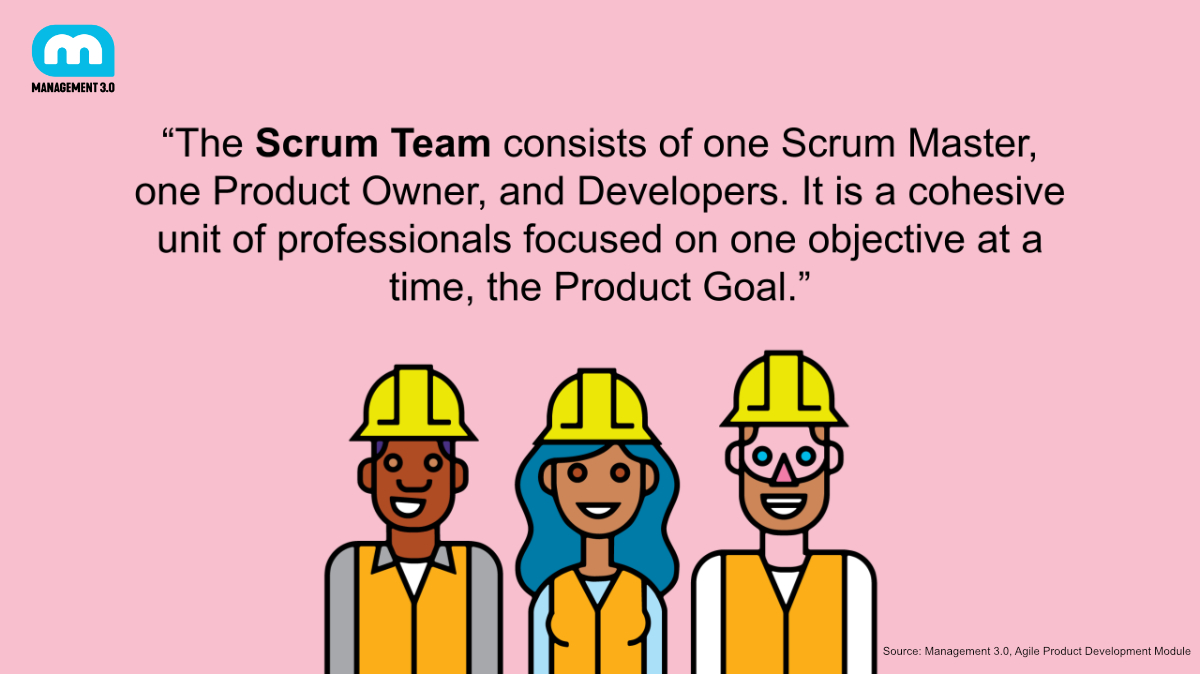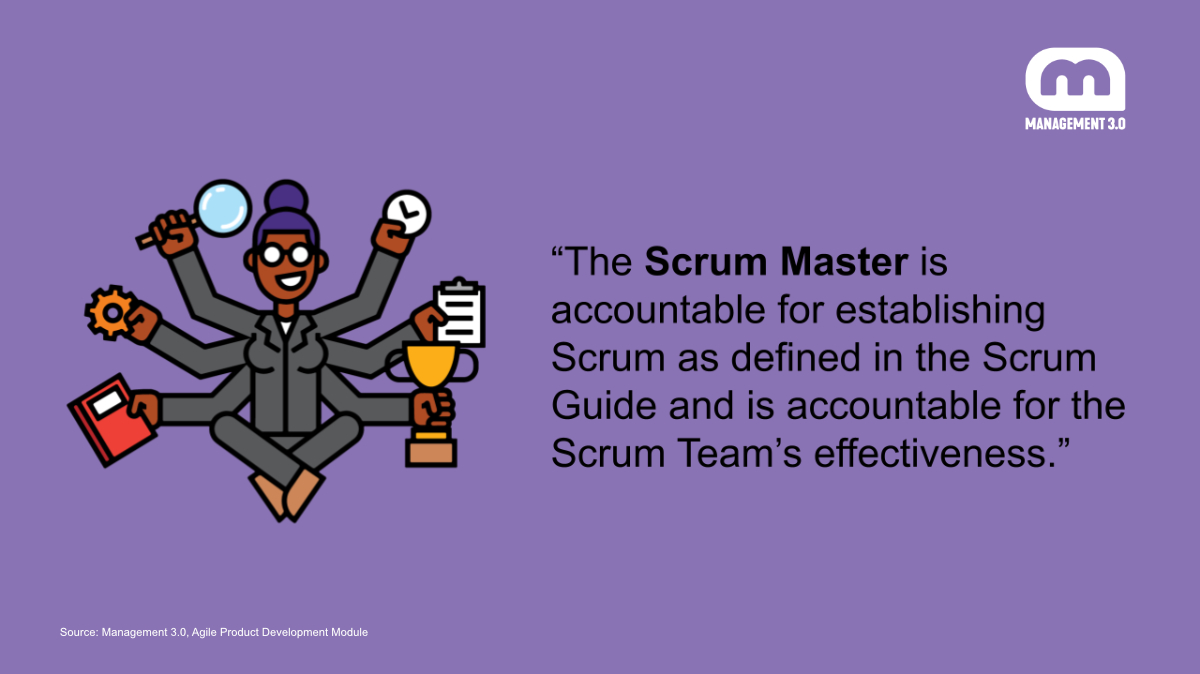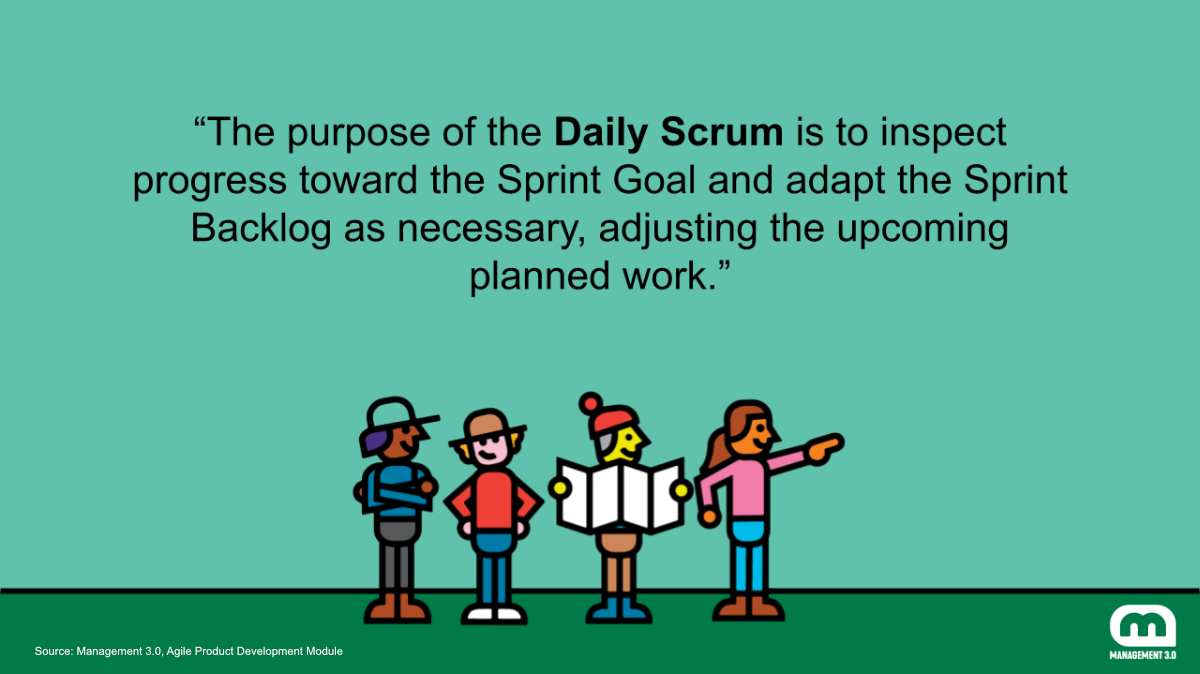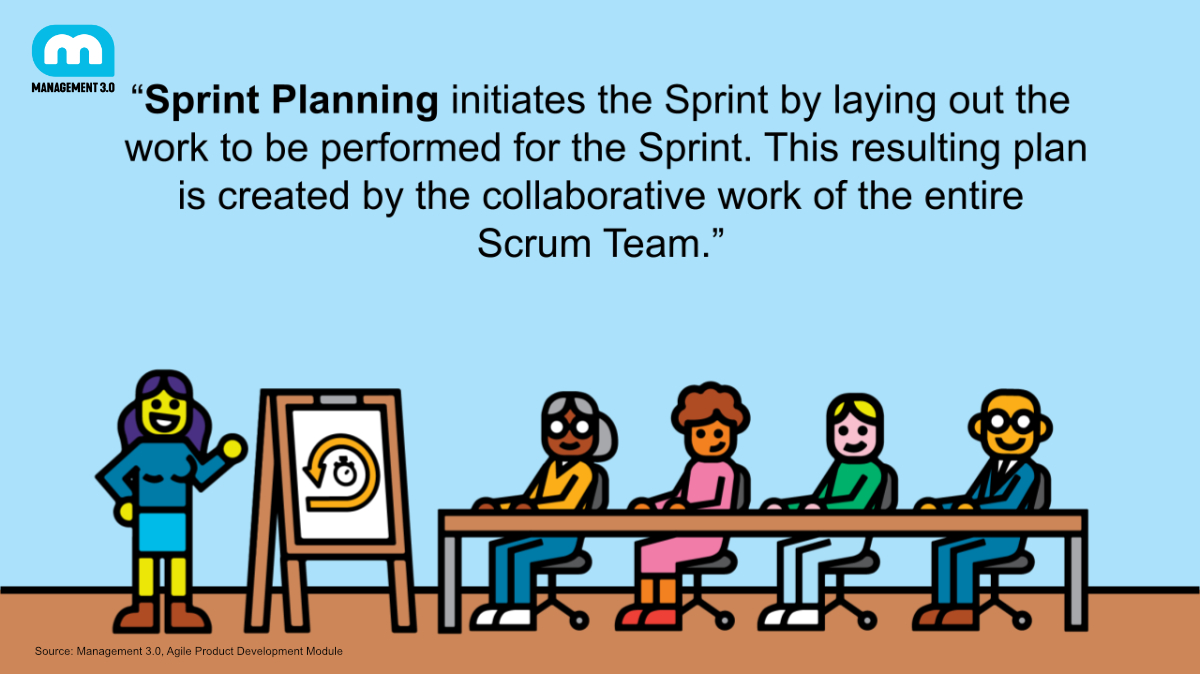Scrum Masters can selectively adopt and adapt Management 3.0 principles and practices to fit their specific contexts and needs. By incorporating the relevant concepts and techniques, Scrum Masters can enhance their effectiveness in supporting Scrum teams and driving successful Agile transformations. This is what Carolina Amaya, Scrum Master and Management 3.0 Facilitator, did. Here is how Management 3.0 helped her to become a better Scrum Master:
- What does it mean to become a better Scrum Master?
- Management 3.0 helps Scrum Masters improving communication and collaboration
- Management 3.0 helps Scrum Masters increasing motivation and commitment
- Management 3.0 helps Scrum Masters with effective change management
- Management 3.0 helps Scrum Masters fostering creativity and innovation
Nearly 3 years ago, on my birthday in June 2020, I discovered Management 3.0 and embarked on a transformative journey. Since then, as a Scrum Master, I have had the privilege of sharing changing and well-being opportunities within organizations. Through the adoption of Management 3.0 practices and tools, I have fostered happy, motivating, and empowered work environments, guiding teams in their successful transition from traditional management approaches, to agile workplaces and personal growth.
As a Scrum Master, I understand the need for guidance on the “how,” which led me to discover Management 3.0 and the approach of playful practices and tools that allow us to experience new ways of working. Personally, this philosophy aligned perfectly with my purpose as a Scrum Master: helping others find happiness in their work and achieve wonderful results by adopting an agile approach to transformation processes. My journey with Management 3.0 has been one of discovery, learning, and transformation, and I want to share the benefits gained by applying these concepts and practices to the workplace.
What does it mean to become a better Scrum Master?
For me, becoming a better Scrum Master is not just about gaining advanced knowledge of Scrum. It means being a facilitative leader capable of guiding and supporting the team in the successful implementation of Scrum and the delivery of high-quality products. It also entails developing effective communication skills, empowering the team, solving problems, fostering continuous learning, and cultivating leadership abilities. It is a journey of personal and professional growth that requires dedication and commitment, but it can lead to exceptional performance as a Scrum Master, while furthering the success of the team and the organization.

Management 3.0 helps Scrum Masters improving communication and collaboration: fostering team success
Management 3.0 emphasizes the importance of continuous learning and improvement. Scrum Masters can use this mindset to encourage teams to regularly reflect on their processes and identify areas for improvement. By facilitating retrospectives and supporting the implementation of improvement actions, Scrum Masters can help teams evolve, while optimizing their performance over time.
One of the most significant challenges facing a Scrum Master is fostering effective communication and collaboration within the team. This is where Management 3.0 practices have been a revelation for me.
By applying these practices, I have improved team communications by ensuring that everyone is aligned on their objectives and execution of tasks.
One of the recommended Management 3.0 practices for fostering or improving communication is “Personal Maps.” By using Personal Maps, team members have the opportunity to share relevant information about themselves in a visual and meaningful way.
This tool promotes empathy, mutual understanding, and the building of stronger relationships among team members. By better understanding each individual’s strengths, interests, and preferences, we promote more effective communication. Task and responsibility assignments also become easier as they are based on each member’s skills and affinities. Additionally, Personal Maps help foster an environment of trust and openness, allowing team members to express their ideas, concerns, or needs more clearly and directly. Overall, this practice contributes to strengthening collaboration and team cohesion, improving the ability to work together effectively and achieve established goals within the agile framework of Scrum.

My experiment as a Scrum Master
I decided to use Personal Maps to improve communication within my Scrum team who were about to start working on a product using the Scrum framework. I wanted to find an effective way to get to know each team member better and facilitate smoother collaboration. So, I organized a session in which I asked everyone to draw their own Personal Map.
During the session, each member shared their map and explained key details about their skills, experience, and preferences. It was amazing to see how each person revealed their strengths and passions, from technical skills, to interests in data analysis and complex problem solving.
As the Personal Maps were presented, I noticed how a deeper connection formed among team members. We began to understand each other better and appreciate the unique skills that each individual brought to the product. This was particularly helpful during sprint planning, as the team members were able to assign tasks which considered each member’s preferences and individual aptitudes. It was rewarding to see how the work was distributed equitably and efficiently, and how everyone felt valued and recognized in their respective areas of expertise.
💡 My takeaways as a Scrum Master
As the work on the product progressed, Personal Maps continued to be an invaluable reference. They helped me to identify opportunities for individual development and growth for each team member.
💡 Tip for other Scrum Masters
I suggest you experiment with Personal Maps yourself. Organize a session where each member creates and shares their own Personal Map; this will foster empathy and mutual understanding. By better understanding each individual, you create a system through which team members can manage tasks according to their strengths and preferences, promoting more effective communication and seamless collaboration.
Management 3.0 helps Scrum Masters increasing motivation and commitment: igniting passion for work
Management 3.0 provides insights into motivation techniques and approaches to enhance team engagement. Scrum Masters can utilize these strategies to foster a positive work environment, boost team morale, and ensure that team members are motivated to deliver high-quality results. This includes recognizing individual and team achievements, providing growth opportunities, and fostering a culture of open communication.
Effective leadership involves motivating and engaging team members. This is where Management 3.0 practices have been a key catalyst in my role as a Scrum Master. By implementing these practices, I have experienced a significant increase in team motivation and commitment. By addressing what drives each individual and providing clear context, I have been able to foster a positive and productive work environment.
Is the Scrum Master the team lead? Explore the dynamics and evolving role of Scrum Masters in Agile teams.
Management 3.0 emphasizes that “motivation comes from allowing people to do the things they care about most in the way they care about most.” By applying Management 3.0 practices, I have learned to understand the individual drive of each team member and provide the necessary support for sustaining their long-term motivation.
One of the recommended Management 3.0 practices for increasing motivation and commitment is “Kudo Cards” This practice promotes recognition and appreciation among team members. By using this tool, I have witnessed how positive behaviors can be reinforced and team relationships can be strengthened. Kudos not only acknowledge individual achievements but also foster collaboration and mutual support as team members encourage and praise one another. This strengthens bonds within the team and promotes a sense of camaraderie and belonging. Additionally, Kudos act as an intrinsic incentive as team members feel motivated to continue giving their best and constantly strive for excellence in their work.

My experiment as a Scrum Master
During a Scrum team retrospective, I noticed that some members were working hard on a challenging initiative and had overcome significant obstacles. I wanted to recognize and celebrate their hard work and accomplishments to promote ongoing motivation and commitment within the team.
I decided to implement Kudos as a form of recognition and begin leading by example. During the next team meeting, I asked everyone to share their standout achievements from the previous sprint. As team members shared their successes, I took note of each one and transformed them into Kudos.
Next, I created personalized Kudo Cards for each team member, highlighting their specific achievement and the positive impact it had on the project. During the subsequent team meeting, I distributed the Kudo Cards and asked members to read them aloud and express their gratitude and recognition for the colleague mentioned on the card.
The response was incredibly positive. Team members felt honored and valued upon receiving Kudos from their peers. I could see their faces light up and their motivation and commitment to the project increase. Furthermore, this act of recognition generated camaraderie and mutual support as team members encouraged and inspired each other.
Kudos not only had an immediate impact on motivation and commitment, but they also created a lasting effect. Team members continued to recognize and value their colleagues’ contributions, which, in turn, reinforced a team culture of recognition and appreciation.
💡 My takeaways as a Scrum Master
Effective recognition, especially as a Scrum Master, is a powerful way to inspire and empower team members. As Management 3.0 highlights, “appropriate recognition can have a tremendous impact on people’s motivation.” By applying Management 3.0 practices, I now value and acknowledge individual and collective achievements; this leads to increased commitment and a more cohesive team.
💡 Tip for other Scrum Masters
Create a space or system in which team members can recognize and appreciate each other’s achievements and positive behaviors. Encourage the team to share their successes and distribute personalized Kudos Cards highlighting specific accomplishments. Celebrate individual and collective achievements openly, creating a culture of recognition and appreciation. By acknowledging and valuing the contributions of team members, you will not only enhance their motivation but also facilitate a supportive and united team environment. Implementing this practice can have a lasting positive impact on the team’s engagement and overall success.
Management 3.0 helps Scrum Masters effective change management: embracing the potential of transformation
Management 3.0 offers tools and practices to facilitate change within organizations. Scrum Masters, being change agents, can benefit from these techniques when introducing Scrum or Agile practices to teams or when helping organizations transition to an Agile way of working. The change management practices provided by Management 3.0 can help Scrum Masters navigate resistance, build a shared understanding, and facilitate smoother transitions.
In today’s business environment, adaptability to change is crucial. As a Scrum Master, I constantly face new challenges when pursuing organizational goals. In this regard, Management 3.0 practices have been an invaluable guide for promoting effective change management. These practices provide us with tools and approaches that enable teams to adapt to new situations and challenges. Change should be seen as an opportunity rather than feared.
Become a better Scrum Master by learning about Management 3.0 and applying its principles and practices. Start with a Foundation Workshop in which you get introduced to Martie and the six organizational views for modern management. Then, continue your journey with our Agile Leadership Workshops: the Agile Change Leadership Workshop for a deep dive on supporting your organization’s change, the Agile Co-Creation Leadership Workshop for fostering innovation and continuous improvement, the Agile People Leadership Workshop and the Agile Team Leadership Workshop.
One of the recommended practices, “Moving Motivators,” has enabled me, as a Scrum Master, to understand how changes impact team motivation and address them accordingly. By actively involving team members in the change process, I have achieved greater rates of acceptance and successfully implemented more planned changes.

My experiment as a Scrum Master
When our team began transitioning to an agile approach, we encountered some resistance and skepticism due to our long history of working in a traditional management environment. Some team members were concerned about changes in roles and responsibilities, as well as adapting to new, more collaborative ways of working.
To address these concerns and facilitate a successful transition, we decided to apply the practice of “Moving Motivators.” We organized a session in which each team member ranked their motivators in relation to digital transformation and agile work.
As we discussed and shared our motivators, interesting conversations and reflections emerged. We were able to identify each member’s key motivators, such as learning, professional growth, recognition, and autonomy. We also noticed that some motivators were common among several team members.
Using this valuable information, we adapted our transformation strategies to focus on individual and collective motivators. For example, we implemented customized training and development programs to enhance learning and professional growth. We also established frequent and transparent recognition practices to value the effort and achievements of each team member.
💡 My takeaways as a Scrum Master
As we progressed in the transformation, we began to notice a positive change in the team’s attitude and commitment. Members felt more inspired and empowered by seeing that their motivators were taken into account and that the new agile approach provided opportunities for growth and meaningful contribution.
💡 Tip for other Scrum Masters
Involve your team members actively in the change process to increase acceptance and successful implementation. Conduct sessions in which team members rank their motivators in relation to the transformation or new initiatives. Facilitate open discussions and reflections based on these motivators to understand individual and collective drivers. You can adapt your strategies and initiatives to align with the identified motivators, providing personalized training, development opportunities, and transparent recognition processes.
Management 3.0 helps Scrum Masters fostering creativity and innovation: paving the way to success
As a Scrum Master, my goal is to foster creativity and innovation within the organization, and Management 3.0 practices have been instrumental in achieving that. These practices have provided me with concrete tools, such as Delegation Poker, that empower the team to propose ideas and make decisions. By applying this practice, I have seen how the commitment and involvement of each team member has strengthened so that they generate valuable ideas and innovative solutions. This collaborative approach has led to continuous improvements in our work processes and enabled us to stay consistently focused on innovation.
“Exploration Days” is another practice which aims to promote learning and continuous development within organizations. Through Exploration Days, also known as hackathons or ShipIt days, employees are invited to conduct experiments and explore new ideas. These sessions provide an opportunity for autonomous and enjoyable learning, promoting self-education as a key to individual and team success. Scheduling time for these types of activities is essential for the growth and success of the organization.

My experiment as a Scrum Master
I implemented the “Exploration Days” practice to reinforce innovative and creative mindsets within our team. I proposed dedicating a full day every quarter for team members to work on personal projects or experiment with new technologies and approaches.
During one of these Exploration Days, a developer decided to investigate the implementation of a new automated testing framework he had been following. Throughout the day, he delved into studying this technology, conducted proof-of-concept tests, and developed a functional prototype.
At the end of the day, he presented his work to the team and demonstrated how this new technology could significantly improve our quality testing and accelerate the development process. His initiative and efforts on this Exploration Day resulted in an innovative and practical solution for our team.
This specific example illustrates how the Exploration Days practice provided team members with the opportunity to dedicate time and energy to projects and experiments that they would not have been able to otherwise pursue due to daily work demands. As a result, we were able to incorporate new ideas and approaches into our daily work, driving innovation and improving our efficiency.
💡 My takeaways as a Scrum Master
The Exploration Days practice has proven to be a valuable tool for promoting imaginative changes within our team, allowing new ideas and solutions to emerge that contribute to the success of our projects.
💡 Tip for other Scrum Masters
Set aside dedicated time for team members to pursue personal projects, experiment with new technologies, and explore innovative ideas. Emphasize the value of autonomy and self-directed learning by generating a culture that encourages creativity and innovation, while celebrating and showcasing the impactful outcomes of these Exploration Days.
What Management 3.0 helps Scrum Masters with
In my own experience as a Scrum Master, Management 3.0 has been an invaluable guide in my professional journey. I emphasize the importance of these practices in building agile, empowered, and committed teams, and I will continue to foster an environment of continuous learning and collaboration.
As Scrum Masters, we play a vital role in organizational transformation processes. We are the guiding individuals who lead teams to success, building a future of agile excellence and employee well-being. We recognize that each of us faces challenges and has individual goals, and upon discovering the powerful practices of Management 3.0, we realize that they can be the key to driving both our own success and that of our teams. By working together, we can achieve great results and take our organizations to the next level.
The practices I shared offer concrete tools that can directly benefit Scrum Masters and the teams they lead. By implementing these practices, a Scrum Master becomes a facilitator of growth and development for their teams. They encourage the motivation, creativity, and innovation of each team member while creating a collaborative and continuously learning environment.
Explore these practices with your own teams, adapting them to the needs and characteristics of your environment. Dare to challenge the status quo, think outside the box, and be courageous in implementing new ideas. I invite you to share your own stories of success and learning with the community so you too can contribute to the growth and development of fellow professionals.
So, if you are a Scrum Master seeking new ways to drive your success and that of your teams, do not hesitate to explore Management 3.0 practices! Open yourself up to new possibilities, dare to innovate, and discover how these practices can transform your approach and your results.

Have you used Management 3.0 practices in agile environments? How can you implement Management 3.0 to promote motivation, creativity, and innovation in your team? What challenges can you overcome by using these tools?
Let’s share our experiences and learn together as we continue to build a path towards agile success. Join this transformation and discover the power of Management 3.0 in your role as a Scrum Master!
Also read:
- Why Management 3.0 is essential for Agile Coaches
- Leadership Skills for Product Owners
- Management 3.0 and Agile?
Header Photo by fauxels (via Pexels)

